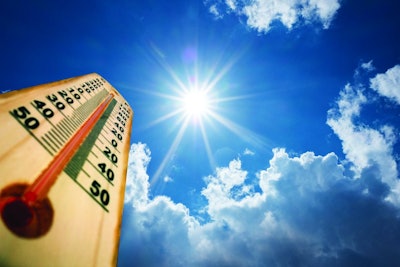
Heat stress is a common issue for broiler producers worldwide. Broilers are highly sensitive to changes in temperature and extreme heat can cause a range of physiological and behavioral problems, resulting in significant economic losses.
Birds are heat stressed when they are unable to achieve a balance between body heat production and body heat loss. This can occur at all ages and in all types of poultry. An ambient temperature above 30 C is considered sufficient to induce heat stress in poultry. Even more extreme conditions occur when high heat is coupled with high humidity.
Unlike other animals, birds do not have sweat glands to help with heat loss. During normal conditions, birds lose heat primarily through radiation, convention and conduction. As temperatures rise, birds resort to evaporation, or panting, to release heat.
While slow panting is a normal activity, the fast panting needed to cope with heat stress will tire birds, cause chemical imbalances and digestive tract inefficiencies, decrease meat quality, reduce growth rates, and can even result in death.
Use the following suggestions to control the impact of rising temperatures on broilers.
Train staff to recognize main heat stress signs
Signs of heat stress include:
- Birds with distended wings, crouched on the floor, with slow movement, or wobbles;
- Increased water consumption;
- Decreased feed consumption;
- Panting faster than normal;
- Skin color changes; and
- Increased mortality, often due to cardiorespiratory failure.
Prepare for a season’s first hot days
Most strategies to control heat stress work better when implemented prior to a heat wave. Use weather reports and seasonal trends to prepare. Consult with an integrator representative prior to the hot season to obtain advice on protecting birds from heat stress.
Manage ventilation
Ventilation, or air flow, is critical to help birds release heat. Measure air flow at bird level. Ensure air flow is sufficient for the barn size and number of birds present. When possible, add supplemental fans to naturally-ventilated barns.
Provide unlimited cool water
Birds must have continuous cool water (below 30 C). Cool water stimulates intake and helps reduce the bird’s body temperature. Birds will increase water intake by 2-4 times in heat stress conditions. Ensure drinkers are operating properly and that birds have sufficient space to access them. Flush water lines and drinkers routinely to keep water fresh and cool.
Keep facilities as updated as economically possible
Improve or adjust lighting programs, consider roof sprinklers, and upgrade to better control of ventilation and temperature within barns. Even when upgrades may not be possible, make sure all current controls within the barn are well maintained and functioning properly.
Adjust bird density
Birds need more room during heat stress conditions. As hotter months approach, consider using a lower stocking density.

Minimize bird movement
Birds need to remain calm during the hottest times of the day. Delay activities such as moving birds or litter conditioning.
Control feeding times
Birds tend to eat more in the morning, which causes increased metabolism due to digestion and makes the birds more susceptible to heat stress. Withdraw feed before the morning rush and at least six hours before heat stress conditions are predicted. Reintroduce feed once temperatures start to decline.
Adjust lighting conditions to promote nighttime eating. Monitor a modified feed program closely to avoid re-introducing feed before birds have recovered from the day’s heat stress. In addition, only modify feeding when you expect heat stress temperatures, since body weight loss and decreased growth can occur.
Modify diet
Feed a more nutrient-dense diet, to compensate for feed intake reduction. Supplement diets with highly digestible ingredients and ensure that the diet is balanced with important amino acids, vitamins and minerals. Speak to a nutritionist about other feed additives, such as probiotics, plant extracts and natural extracts.
Use drinking water additives
Since birds are eating less, the addition of vitamins and electrolytes to water can help to compensate for feed nutrient losses. Vitamins such as A, D, E and B complex can be effective in reducing heat stress mortality in broilers. Electrolytes compensate for heat stress induced by loss of potassium, sodium, phosphorus, magnesium and zinc. Potassium, in particular, may also increase drinking water consumption. Electrolytes should be started prior to the heat stress period.
Long term, the following approaches may provide additional support. Discuss the following with an integrator’s service representative.
- Select breeding stock that are less susceptible to heat. Birds that have been genetically selected for faster growth tend to have lowered heat tolerance. Consider using a slower growing bird when heat stress conditions are predicted.
- Expose chicks to higher temperatures. Research suggests that exposing chicks to higher temperatures in the first few days of life may promote their ability to maintain a lower body temperature even under heat stress conditions.
- Embryonic manipulation: both in ovo nutrient supplementation and thermal manipulation of eggs during incubation are being evaluated for their potential to provide greater heat tolerance post-hatch.

















